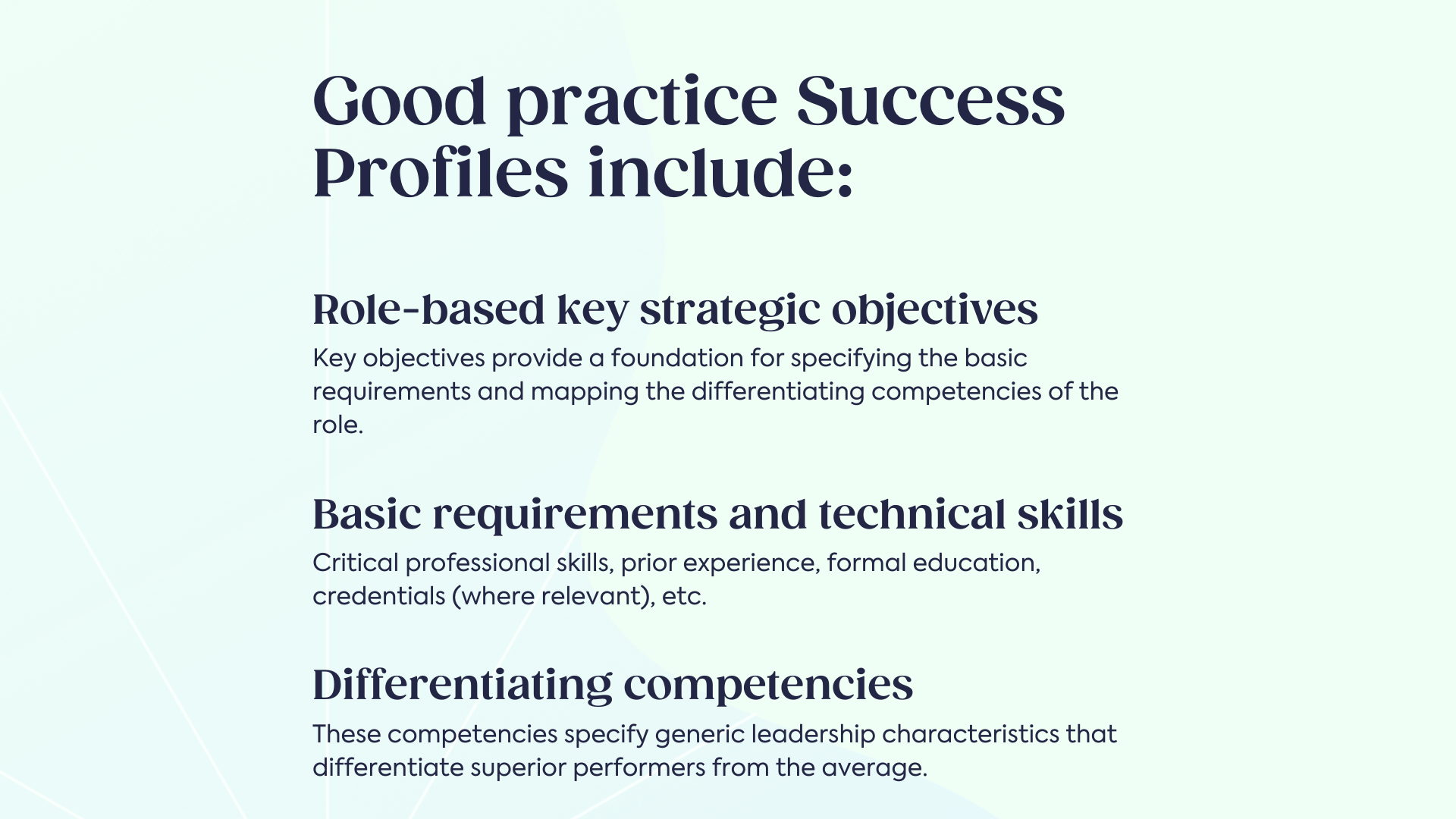Navigating the leadership succession process in private equity: a comprehensive guide
Ott Niggulis
High-performing private equity teams understand value creation is primarily about talent, teamwork, and a high-performance culture.
The impact of talent and talent decisions on a company's bottom line is immense. Research has found that portfolio company leadership has a 15% impact on financial performance and a 30% impact on market valuation.
These stats make an excellent case for why portfolio companies should have a full-fledged succession planning process. The problem is that a whopping 97% of private equity-backed company CEOs admit that their succession plans have weaknesses.
Why succession planning matters
Succession planning is a process that ensures the continuity of leadership in an organisation - a ready-made pipeline of leaders ready to take over the company's running.
This is especially important in the fast-moving world of private equity-backed companies where getting talent decisions right is critically important. Portfolio companies have to achieve clear goals set out in the value creation plan in a short period of time.
The caveat? 64% of both private equity investors and portfolio company CEOs admit they don’t have a suitable successor identified either for the CEO nor for the CFO or COO roles.
And people will leave. Data from AlixPartners shows that an astonishing 73% of CEOs are likely to be replaced during the investment life cycle. Of those replacements, 30% will be replaced.
64% of both private equity investors and portfolio company CEOs admit they don’t have a suitable successor identified either for the CEO nor for the CFO or COO roles.
Portfolio companies do not have the luxury of being unprepared when key members of the team leave and the drawn out hiring processes that follow.
A regularly refreshed and robust succession plan can help by creating a focus on development and career planning inside portfolio companies and helps retain high-potential leaders already in the company and attract other A-players into the organisation.
"We have worked together enough time to understand who is who, but Wisnio Profiles help us to better accept and understand each other's strengths and areas where we complement each other."
Margus Uudam - Founding Partner, Karma Ventures
The first steps
In any other company, the first steps in setting up a succession planning process are aligning the business with clear goals and determining the roles pivotal to achieving those results.
In private equity, the business goals are already covered in the value creation plan, which includes the strategies essential to generating attractive returns.
Get your succession process started with Wisnio today. Sign up is free.
Firms with the highest success rates go one step further and map the strategies to the key roles with clear and measurable objectives for each role. That then leads to precise job descriptions that spell out the unique set of experiences, capabilities, and motivations required for success.
These key roles highlighted in the value creation plan are the roles that are going to be targeted by succession planning. And thus ensuring that if any of the key members leave, the company can quickly fill the vacancy with people who have been trained and are ready to hit the ground running.
The first step in achieving that is developing Success Profiles for each of the critical roles identified.
Firms with the highest success rates go one step further and map the strategies to the key roles with clear and measurable objectives for each role.
1. Develop Success Profiles

Success Profiles are like maps that define the skills, experiences, and other characteristics necessary for success in a particular leadership role. These profiles serve as a roadmap for employees to follow as they develop their careers and prepare to take on leadership positions within the organisation.
As a good practice, each Success Profile has to include the following:
- Role-based key strategic objectives
Key objectives provide a foundation for specifying the basic requirements and mapping the differentiating competencies of the role. - Basic requirements and technical skills
Critical professional skills, prior experience, formal education, credentials (where relevant), etc. - Differentiating competencies
These competencies specify generic leadership characteristics that differentiate superior performers from the average.
And many of these criteria are easy to understand and thereby assess. For example:
- Does the candidate have four years of experience in enterprise sales - yes or no?
- Has the candidate worked at a financial institution - yes or no?
- Same with technical skills - they either know how to do something or don't.
But value creation is not just about talent. It’s also about working together as a team. Everyone works in a team, and thereby collaboration and a good working relationship with teammates are important. And while skills and competencies are relatively easy to assess, determining team fit is a slightly more involved process.
At Wisnio, we use a combination of behavioural science and machine learning to bring data into understanding person and team fit. We use assessments based on proven academic frameworks, which have demonstrated high accuracy and strong predictive power in various settings and cultures.
Everyone works in a team, and thereby collaboration and a good working relationship with teammates are imperative.
These data give you objective insights into individuals' deep-level characteristics and motivations, which helps leaders like you better understand the candidates they interview and how well they will fit into the teams they'll be joining.
Used together with scorecards and behavioural interviewing techniques, this approach ensures a bias-free and fair process for everyone involved.

Scorecards
Emotion and personal feelings often play a role in decision-making, and rarely do they make them better. To remove emotions and bias, we recommend using scorecards as a companion to Success Profile, as they help evaluate each candidate in a fair and unbiased way.
Essentially, scorecards are a series of criteria with specific questions to check whether a candidate matches the criterion. Each criterion is evaluated separately, and the scores are added to give each candidate an overall score.
Using scorecards with all candidates gives you a clear and focused overview of the candidates, how they compare against each other, and their individual key development areas.
Learn more: How to use hiring scorecards for better talent assessment
2. Evaluate candidates
Before the evaluation process can begin, you'll need to have a pool of candidates for each position. Exactly how many depends mainly on the size of the organisation.
At a minimum, each position should have three candidates ready to be evaluated. Why? Having three candidates makes it an actual process, not just a choice between two people.
When compiling candidate shortlists, the knowledge and experience of the leadership team are invaluable. After all, they work with people in their functional areas daily and thus can pinpoint those who have shown potential.
Additionally, use the requirements, technical skills, and differentiating competencies from the corresponding Success Profile to pinpoint people who might fit the criteria but don’t necessarily currently work in the same functional area.
Conducting evaluation interviews
For the actual evaluation, we recommend using behavioural interviewing techniques whereby candidates are asked to provide specific examples from their past employment and how they behaved in those circumstances.
For each requirement from the Success Profile, candidates are asked predefined questions to validate that they have demonstrated the required behaviours and competencies. Each criterion is evaluated separately, and the scores are added together to give each candidate an overall score.
For example, when one of the requirements in the Success Profile is a demonstrated ability to build a high-performing sales culture, ask the candidate to describe a compensation and motivation scheme they put in place.
To better understand how a Success Profile looks like, take a look at our library of Hiring Scorecards. They use the same basic structure of key strategic objectives, basic requirements and technical skills, and differentiating competencies.
Skills, knowledge, and experience are relatively easy to acquire, but changing a person's values and behavioural patterns is much more challenging, if not impossible.
Another important aspect of evaluating candidates, besides the vital skills, knowledge, and experience, is the fit between the candidate and the team they would be potentially joining.
Skills, knowledge, and experience are relatively easy to acquire, but changing a person's values and behavioural patterns to fit into a team is much more challenging, if not impossible.
To check for team fit, use a talent analytics or assessment tool that specifically analysis team fit - an analytics tool like Wisnio.
Learn more: A 3-step guide to behavioral interviewing success
3. Create development plans for internal candidates
The results of the process outlined above give you a clear picture of the company's current state of succession and a clear understanding of key development areas for each candidate.
The next steps include creating development plans for the candidates with the highest potential in collaboration with the company's learning and development, human resources, and other relevant teams.
Typically, these plans include goals, learning and development activities, and support mechanisms that will help an employee grow and advance in their career, as well as a plan for how the employee and their manager will work together to support the employee's growth and development.
These plans provide employees with a clear roadmap for advancing in their careers and help managers provide the support and resources needed to help employees reach their goals.
Additionally, the data collected can be used to develop company-specific leadership profiles. These profiles can be used to evaluate employees' leadership potential and be used as a guide for company-wide leadership development programs.
Conclusions
Reviewing and building your talent pool is not something that just happens. It’s a continuous process that needs clear leadership buy-in and people willing to drive the process from within the organisation.
In private equity-backed companies, it also means aligning your succession process with the value creation plan and the key roles that come from it.
After that, it’s a relatively easy three-step process:
- Develop Success Profiles with accompanying scorecards
- Evaluate candidates with behaviour-based interviewing
- Create development plans for the most promising candidate
Get your succession process started with Wisnio's talent analytics platform today. Sign up is free.